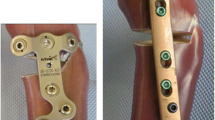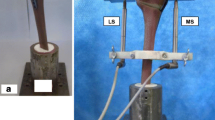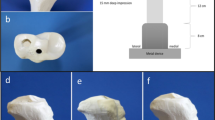Abstract
Introduction
The aim of this study was to test the mechanical stability of LOQTEQ® HTO plate in comparison to the TomoFix™ internal plate fixator.
Materials and methods
An unstable fracture gap model with two standardized polyoxymethylene (POM) cylinders was used for this study. With this model 5 LOQTEQ® HTO plates and 5 TomoFix™ were cyclically loaded. The start load was 100 N and increased by 50 N after each successful completed cycle. Each load step included 250,000 cycles. All tests were performed in accordance with the American Society for Testing and Materials (ASTM) Standard Specification and Test Method for Metallic Bone Plates F382–99(2003)e1.
Results
The mean fatigue strength of the LOQTEQ® HTO Plate was 155 % of the value gained by the TomoFix™ implant. This difference was statistically significant (t test <0.001). There was also a significant difference in the cycles but both implants survived. The LOQTEQ® HTO Plate system survived 1,520,336.8 (±121,687.7) cycles, whereas the TomoFix™ group passed on average 847,802,600 (±134,660.7) cycles. In both groups, the only failure mode was plate breakage in a shaft hole.
Conclusions
The results of the present study showed that fatigue strength of the LOQTEQ® HTO plate was significantly higher in comparison to TomoFix™. These results justify the clinical use of the LOQTEQ® HTO plate.





Similar content being viewed by others
References
Agneskirchner JD, Freiling D, Hurschler C, Lobenhoffer P (2006) Primary stability of four different implants for opening wedge high tibial osteotomy. Knee Surg Sports Traumatol Arthrosc 14(3):291–300
Ahmad M, Nanda R, Bajwa AS, Candal-Couto J, Green S, Hui AC (2007) Biomechanical testing of the locking compression plate: when does the distance between bone and implant significantly reduce construct stability? Injury 38(3):358–364
Annual book of ASTM Standards, ASTM International (2004) American Society for Testing & Materials
Bode G, von Heyden J, Pestka J, Schmal H, Salzmann G, Südkamp N, Niemeyer P (2013) Prospective 5-year survival rate data following open-wedge valgus high tibial osteotomy. Knee Surg Sports Traumatol Arthrosc 19 (Epub ahead of print)
Brinkman JM, Lobenhoffer P, Agneskirchner JD, Staubli AE, Wymenga AB, van Heerwaarden RJ (2008) Osteotomies around the knee: patient selection, stability of fixation and bone healing in high tibial osteotomies. J Bone Joint Surg Br 90(12):1548–1557
Estes C, Rhee P, Shrader MW, Csavina K, Jacofsky MC, Jacofsky DJ (2008) Biomechanical strength of the Peri-Loc proximal tibial plate: a comparison of all-locked versus hybrid locked/nonlocked screw configurations. J Orthop Trauma 22(5):312–316
Floerkemeier S, Staubli AE, Schroeter S, Goldhahn S (2013) Lobenhoffer P (2013) Outcome after high tibial open-wedge osteotomy: a retrospective evaluation of 533 patients. Knee Surg Sports Traumatol Arthrosc 21(1):170–180
Florin M, Arzdorf M, Linke B, Auer JA (2005) Assessment of stiffness and strength of 4 different implants available for equine fracture treatment: a study on a 20 degrees oblique long-bone fracture model using a bone substitute. Vet Surg 34(3):231–238
Gaebler C, Speitling A, Milne EL, Stanzl-Tschegg S, Vecsei V, Latta LL (2001) A new modular testing system for biomechanical evaluation of tibial intramedullary fixation devices. Injury 32(9):708–712
http://asm.matweb.com/search/SpecificMaterial.asp?bassnum=MTP641. Accessed 7 July 2014
http://www.makeitfrom.com/compare-materials/?A=Commercially-Pure-Titanium&B=Grade-5-6Al-4V-3.7165-R56400-Titanium. Accessed 7 July 2014
Irubetagoyena I, Verset M, Palierne S, Swider P, Autefage A (2013) Ex vivo cyclic mechanical behaviour of 2.4 mm locking plates compared with 2.4 mm limited contact plates in a cadaveric diaphyseal gap model. Vet Comp Orthop Traumatol 26(6):479–488
Jung WH, Chun CW, Lee JH, Ha JH, Kim JH, Jeong JH (2013) Comparative study of medial opening-wedge high tibial osteotomy using 2 different implants. Arthroscopy 29(6):1063–1071
Kobayashi S, Ohgoe Y, Ozeki K, Hirakuri K, Aoki H (2007) Dissolution effect and cytotoxicity of diamond-like carbon coatings on orthodontic archwires. J Mater Sci Mater Med 18(12):2263–2268
Lobenhoffer P, Agneskirchner J, Zoch W (2004) Open valgus alignment osteotomy of the proximal tibia with fixation by medial plate fixator. Orthopade 33(2):153–160
Luo CA, Hua SY, Lin SC, Chen CM, Tseng CS (2013) Stress and stability comparison between different systems for high tibial osteotomies. BMC Musculoskelet Disord 25(14):110. doi:10.1186/1471-2474-14-110
Luites JW, Brinkman JM, Wymenga AB, van Heerwaarden RJ (2009) Fixation stability of opening- versus closing-wedge high tibial osteotomy: a randomised clinical trial using radiostereometry. J Bone Joint Surg Br 91(11):1459–1465
Matsushita K, Inoue N, Totsuka Y (2011) In vitro biomechanical evaluation of the effect of an additional L-shaped plate on straight or box plate fixation in sagittal split ramus osteotomy using a bioabsorbable plate system. Oral Maxillofac Surg 15(3):139–146
Niemeyer P, Schmal H, Hauschild O, von Heyden J, Südkamp NP, Köstler W (2010) Open-wedge osteotomy using an internal plate fixator in patients with medial-compartment gonarthritis and varus malalignment: 3-year results with regard to preoperative arthroscopic and radiographic findings. Arthroscopy 26(12):1607–1616
Schröter S, Gonser CE, Konstantinidis L, Helwig P, Albrecht D (2011) High complication rate after biplanar open wedge high tibial osteotomy stabilized with a new spacer plate (Position HTO plate) without bone substitute. Arthroscopy 27(5):644–652
Spahn G (2004) Complications in high tibial (medial opening wedge) osteotomy. Arch Orthop Trauma Surg 124(10):649–653
Staubli AE (2011) Open-wedge high tibial osteotomy with a locking plate (tomofix) for treatment of medial monocompartment osteoarthritis. Elsevier 21(2):156–162
Staubli A, Hilaire A, Jacob C (2010) Evolution of open-wedge high-tibial osteotomy: experience with a special angular stable device for internal fixation without interposition material. Int Orthop 34(2):167–172
Staubli AE, De Simoni C, Babst R, Lobenhoffer P (2003) TomoFix: a new LCP-concept for open wedge osteotomy of the medial proximal tibia—early results in 92 cases. Injury 34(Suppl 2):B55–B62
Uhl JM, Seguin B, Kapatkin AS, Schulz KS, Garcia TC, Stover SM (2008) Mechanical comparison of 3.5 mm broad dynamic compression plate, broad limited-contact dynamic compression plate, and narrow locking compression plate systems using interfragmentary gap models. Vet Surg 37(7):663–673
van den Bekerom MP, Patt TW, Kleinhout MY, van der Vis HM, Albers GH (2008) Early complications after high tibial osteotomy: a comparison of two techniques. J Knee Surg 21:68–74
Author information
Authors and Affiliations
Corresponding author
Rights and permissions
About this article
Cite this article
Petersen, W., Wall, A., Paulin, T. et al. Stability of two angular stable locking plates for open wedge high tibial osteotomy (HTO): TomoFix™ versus LOQTEQ® HTO plate. Arch Orthop Trauma Surg 134, 1437–1442 (2014). https://doi.org/10.1007/s00402-014-2042-4
Received:
Published:
Issue Date:
DOI: https://doi.org/10.1007/s00402-014-2042-4




